Influence of Blade Thickness on Solid–Liquid Two-Phase Flow and Impeller Wear in a Ceramic Centrifugal Slurry Pump
Abstract
:1. Introduction
2. Pump Geometry
3. Numerical Model and Methods
3.1. Computational Domain and Grid Meshing
3.2. Mathematical Model
3.3. Preprocessing
4. Results and Discussion
4.1. Contours of the Solid Fractions on the Surfaces of the Impeller Blades
4.2. Streamlines of Time-Averaged Relative Velocity of the Solid Particles on the Impeller Back Shroud
4.3. Time-Averaged Flow Angles of the Solid Particles in the Impeller
5. Wear Testing
5.1. Test Rig
5.2. Test Method
5.3. Test Results
6. Conclusions
- (1)
- As the blade thickness increases, the vm of water increases due to the decrease in the flow area of the impeller passages, resulting in an increase in the relative flow angle. Hence, the incident angles of the solid particles increase under the effect of the flow field, which leads to larger wrap angles of the particle trajectories in the impeller passages.
- (2)
- As the wrap angles of the solid trajectories in the impeller passages increase, it takes a longer time for the solid particles to collide with the blade pressure side, so the region where the collisions take place between the solid particles and the blade pressure side is offset towards the impeller exit.
- (3)
- As the blade thickness increases, the number of solid particles colliding with the blade leading edges decreases, and the particles are more likely to collide with the blade suction side.
- (4)
- Increasing the blade thickness alleviates the abrasion of the leading edges and the pressure side of the impeller blades and makes the abrasion of the back shroud more uniform. However, the blade suction side is abraded more severely, and the hydraulic performance of the pump decreases.
- (5)
- The solid particle volume fractions show good agreement with the wear patterns on the back shroud and the blade suction sides of the tested impellers. Meanwhile, the solid particle trajectories are in accordance with the wear patterns on the blade pressure sides of the tested impellers. These prove that the numerical method adopted in this paper can predict the abrasion of impellers in ceramic slurry pumps.
Author Contributions
Funding
Conflicts of Interest
References
- Berenin, V.V. Ceramic centrifugal pumps for the chemical and petroleum industries. Chem. Pet. Eng. 2002, 38, 472–475. [Google Scholar] [CrossRef]
- Tao, Y.; Yuan, S.; Liu, J.; Zhang, F.; Tao, J. Influence of blade thickness on transient flow characteristics of centrifugal slurry pump with semi-open impeller. Chin. J. Mech. Eng. 2016, 29, 1209–1217. [Google Scholar] [CrossRef]
- Cavazzini, G.; Pavesi, G.; Santolin, A.; Ardizzon, G.; Lorenzi, R. Using splitter blades to improve suction performance of centrifugal impeller pumps. Proc. Inst. Mech. Eng. Part A J. Power Energy 2015, 229, 309–323. [Google Scholar] [CrossRef]
- Li, S.; Wu, P.; Wu, D. Hydraulic optimization and loss analyses of a low specific-speed centrifugal pump with variable-thickness blades. In Proceedings of the ASME 2016 Fluids Engineering Division Summer Meeting, Washington, DC, USA, 10–14 July 2016. [Google Scholar]
- Gao, B.; Zhang, N.; Li, Z.; Ni, D.; Yang, M. Influence of the blade trailing edge profile on the performance and unsteady pressure pulsations in a low specific speed centrifugal pump. ASME J. Fluids Eng. 2016, 138, 051106. [Google Scholar] [CrossRef]
- Kim, Y.I.; Kim, S.; Yang, H.M.; Lee, K.Y.; Choi, Y.S. Analysis of internal flow and cavitation characteristics for a mixed-flow pump with various blade thickness effects. J. Mech. Sci. Technol. 2019, 33, 3333–3344. [Google Scholar] [CrossRef]
- Kim, S.J.; Choi, Y.S.; Cho, Y.; Choi, J.W.; Kim, J.H. Effect of runner blade thickness on flow characteristics of a francis turbine model at low flowrates. ASME J. Fluids Eng. 2020, 142, 031104. [Google Scholar] [CrossRef]
- Wu, C.; Zhang, W.; Wu, P.; Yi, J.; Ye, H.; Huang, B.; Wu, D. Effects of blade pressure side modification on unsteady pressure pulsation and flow structures in a centrifugal pump. ASME J. Fluids Eng. 2021, 143, 111208. [Google Scholar] [CrossRef]
- Chang, H.; Li, W.; Shi, W.; Liu, J. Effect of blade profile with different thickness distribution on the pressure characteristics of novel self-priming pump. J. Braz. Soc. Mech. Sci. Eng. 2018, 40, 518. [Google Scholar] [CrossRef]
- Jin, Y.X.; Song, W.W.; Jie, F. A study on the effects of blade thickness on the performance of low specific speed centrifugal pump. Adv. Mater. Res. 2015, 1070–1072, 1957–1962. [Google Scholar] [CrossRef]
- Tao, Y.; Yuan, S.; Liu, J.; Zhang, F.; Tao, J. The influence of the blade thickness on the pressure pulsations in a ceramic centrifugal slurry pump with annular volute. Proc. Inst. Mech. Eng. Part A J. Power Energy 2017, 231, 415–431. [Google Scholar] [CrossRef]
- Qian, B.; Wu, P.; Huang, B.; Zhang, K.; Li, S.; Wu, D. Optimization of a centrifugal impeller on blade thickness distribution to reduce hydro-induced vibration. ASME J. Fluids Eng. 2020, 142, 021202. [Google Scholar] [CrossRef]
- Deng, Q.; Song, W.; Zhou, Y.; Su, K.; Tao, C. Research on the influence of cooperative design of blade number and blade thickness on the characteristics of the centrifugal pump. China Rural Water Hydropower 2021, 2021, 31–36. [Google Scholar]
- Cheng, W.; Gu, B.; Shao, C.; Wang, Y. Hydraulic characteristics of molten salt pump transporting solid-liquid two-phase medium. Nucl. Eng. Des. 2017, 324, 220–230. [Google Scholar] [CrossRef]
- Tarodiya, R.; Gandhi, B.K. Numerical simulation of a centrifugal slurry pump handling solid-liquid mixture: Effect of solids on flow field and performance. Adv. Powder Technol. 2019, 30, 2225–2239. [Google Scholar] [CrossRef]
- Peng, G.; Huang, X.; Zhou, L.; Zhou, G.; Zhou, H. Solid-liquid two-phase flow and wear analysis in a large-scale centrifugal slurry pump. Eng. Fail. Anal. 2020, 114, 104602. [Google Scholar] [CrossRef]
- Wang, Y.; Chen, B.; Zhou, Y.; Ma, J.; Zhang, X.; Zhu, Z.; Li, X. Numerical simulation of fine particle solid-liquid two-phase flow in a centrifugal pump. Shock. Vib. 2021, 2021, 6631981. [Google Scholar]
- Huang, S.; Zou, W.L.; Zhou, J.J.; He, D.P.; Peng, T.Y. Unsteady numerical simulation on solid-liquid flows and wear in a centrifugal pump based on DPM model. China Rural Water Hydropower 2016, 44, 103–106. [Google Scholar]
- Lai, F.; Wang, Y.; EI-Shahat, S.A.; Li, G.; Zhu, X. Numerical study of solid particle erosion in a centrifugal pump for liquid-solid flow. ASME J. Fluids Eng. 2019, 141, 121302. [Google Scholar] [CrossRef]
- Wang, Y.; Han, C.; Zhou, Y.; Lin, Z.; Ma, J.; Li, X.; Zhang, W. Wear characteristics of dense fine particles solid-liquid two-phase fluid centrifugal pump with open impellers. Shock. Vib. 2021, 2021, 6635630. [Google Scholar]
- Huang, S.; Su, X.; Qiu, G. Transient numerical simulation for solid-liquid flow in a centrifugal pump by DEM-CFD coupling. Eng. Appl. Comput. Fluid Mech. 2015, 9, 411–418. [Google Scholar] [CrossRef] [Green Version]
- Huang, S.; Huang, J.; Guo, J.; Mo, Y. Study on wear properties of the flow parts in a centrifugal pump based on EDEM-Fluent coupling. Processes 2019, 7, 431. [Google Scholar] [CrossRef] [Green Version]
- Shao, W.; Zhao, R.; Zhang, D. Erosion of multistage mixed flow pump based on fully coupled CFD-DEM method. Chin. J. Hydrodyn. 2020, 35, 640–648. [Google Scholar]
- Li, Y.; Yuan, S.; Wang, X.; Keat Tan, S.; Mao, J. Comparison of flow fields in a centrifugal pump among different tracer particles by particle image velocimetry. ASME J. Fluids Eng. 2016, 138, 061105. [Google Scholar] [CrossRef]
- Shi, B.; Wei, J.; Zhang, Y. A novel experimental facility for measuring internal flow of solid-liquid two-phase flow in a centrifugal pump by PIV. Int. J. Multiph. Flow 2017, 89, 266–276. [Google Scholar] [CrossRef]
- Tan, M.; Zhang, K.; Wu, X.; Liu, H. Experimental study on large particle solid-liquid two-phase flow in a centrifugal pump. Trans. Chin. Soc. Agric. Eng. 2021, 37, 62–67. [Google Scholar]
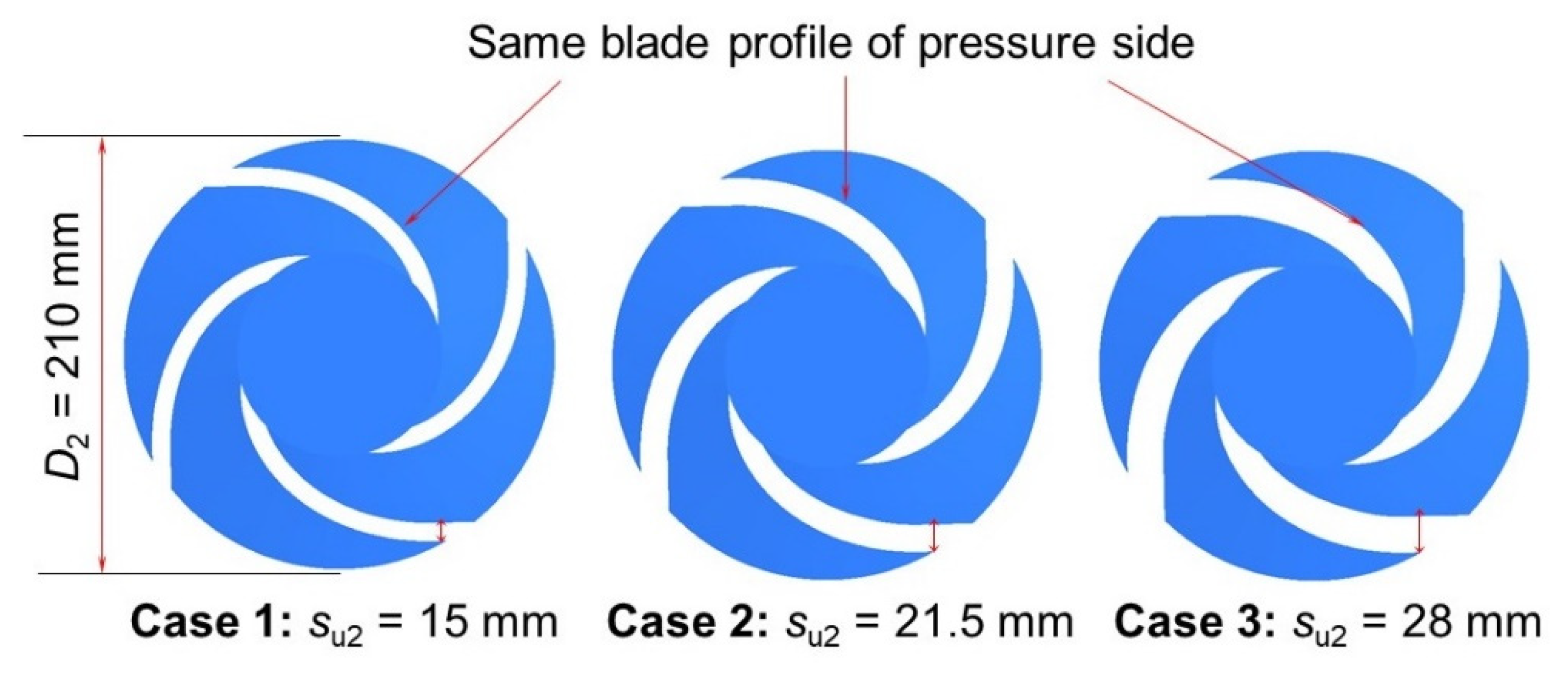
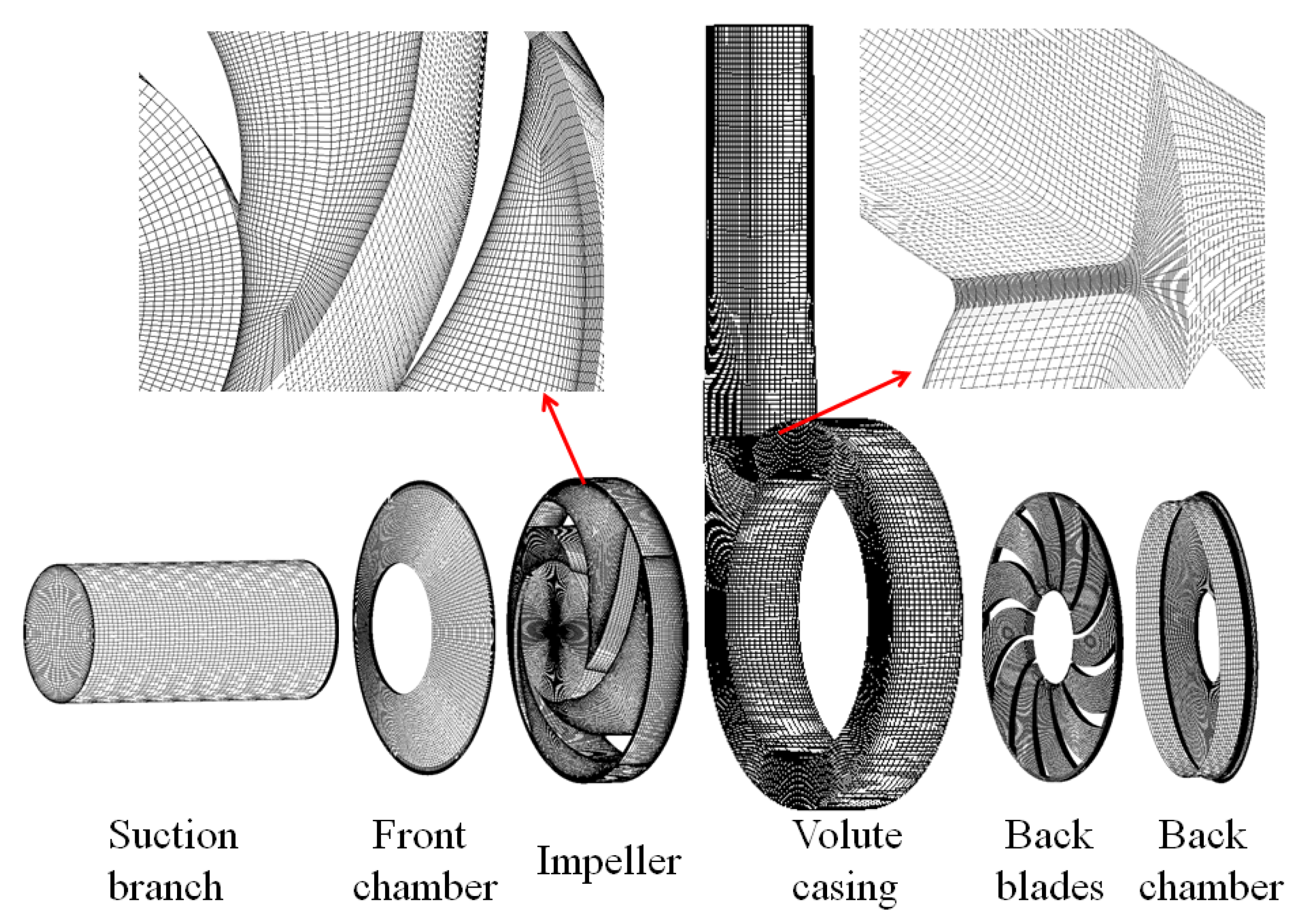

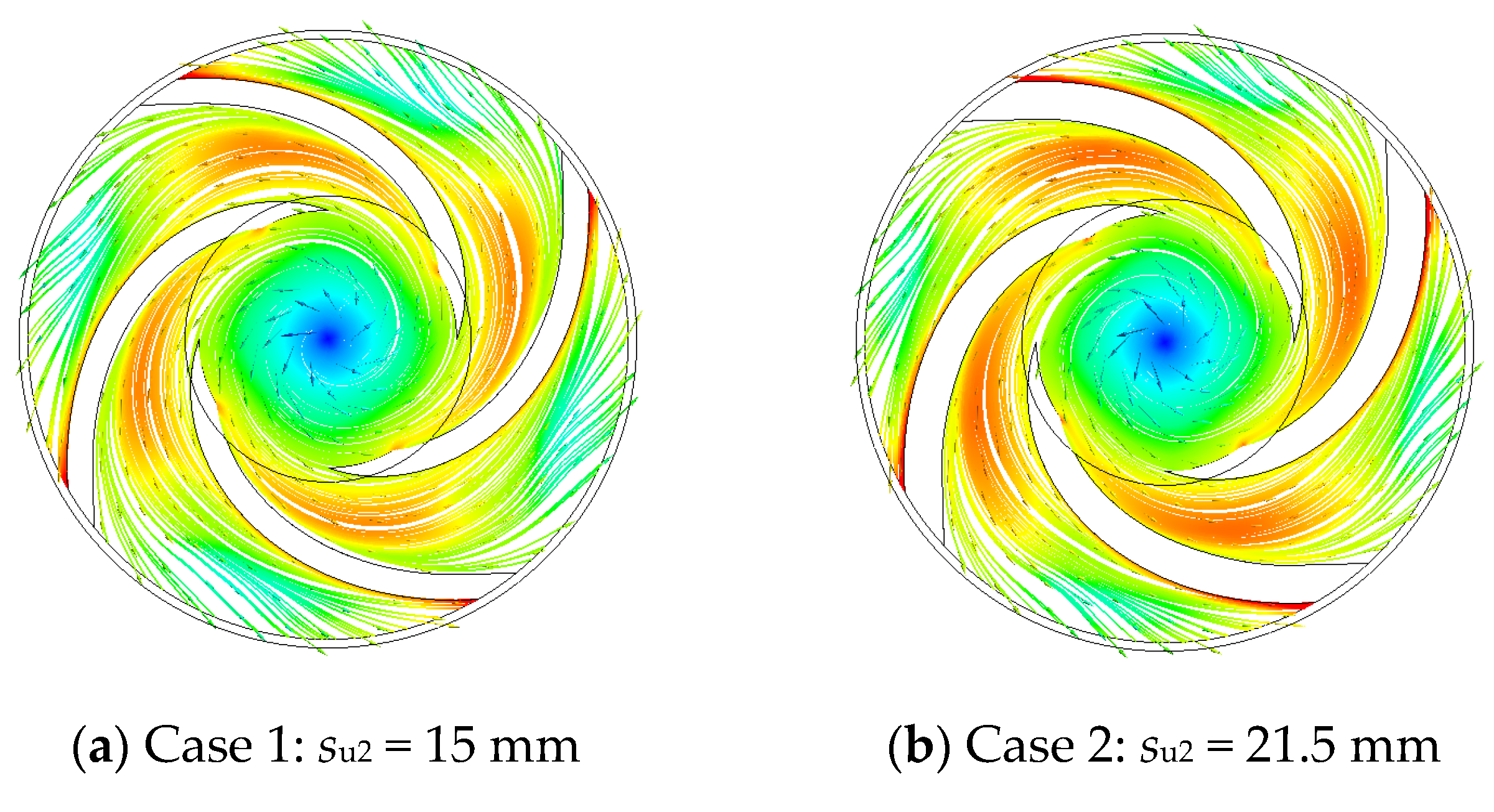
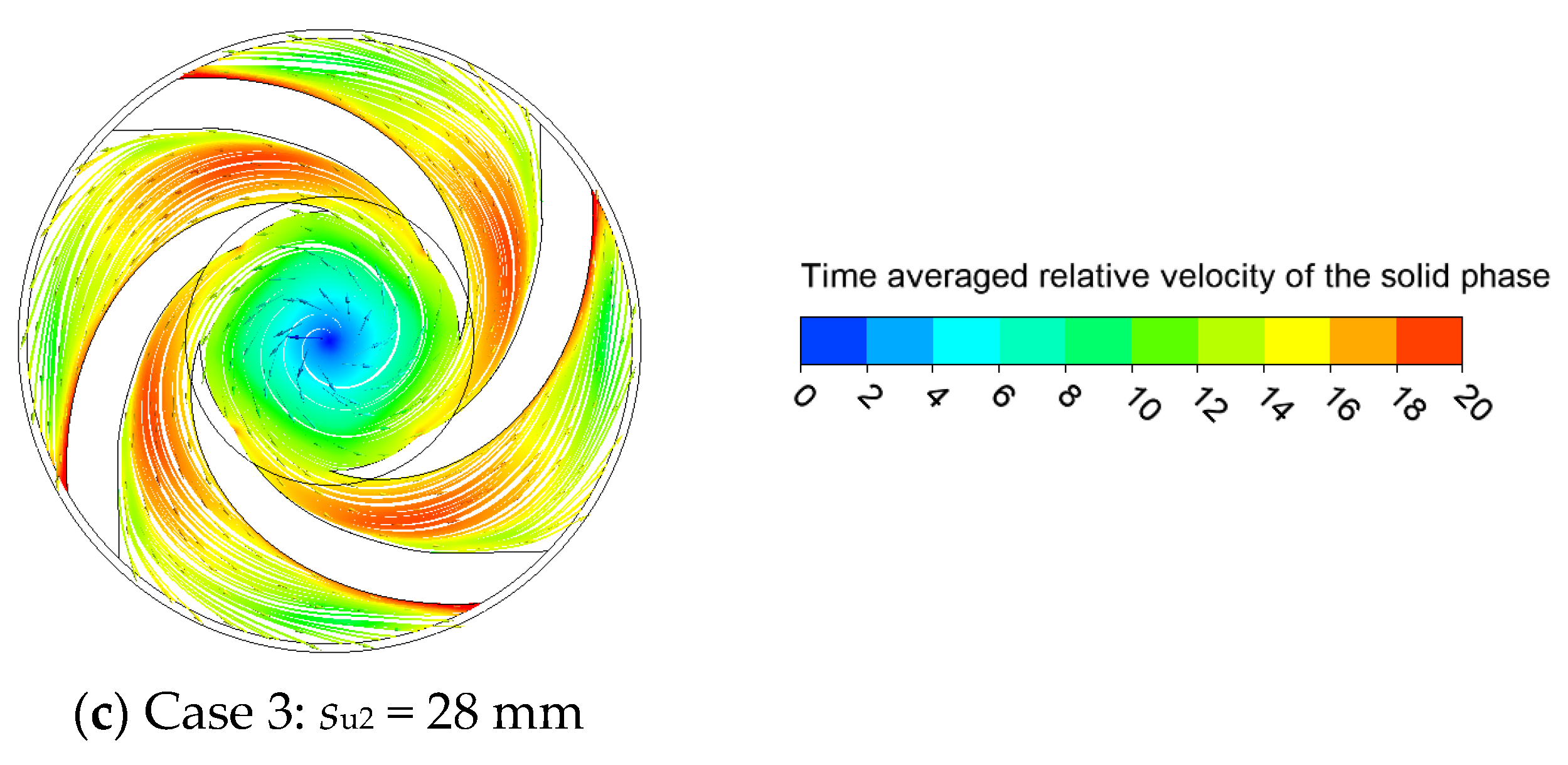
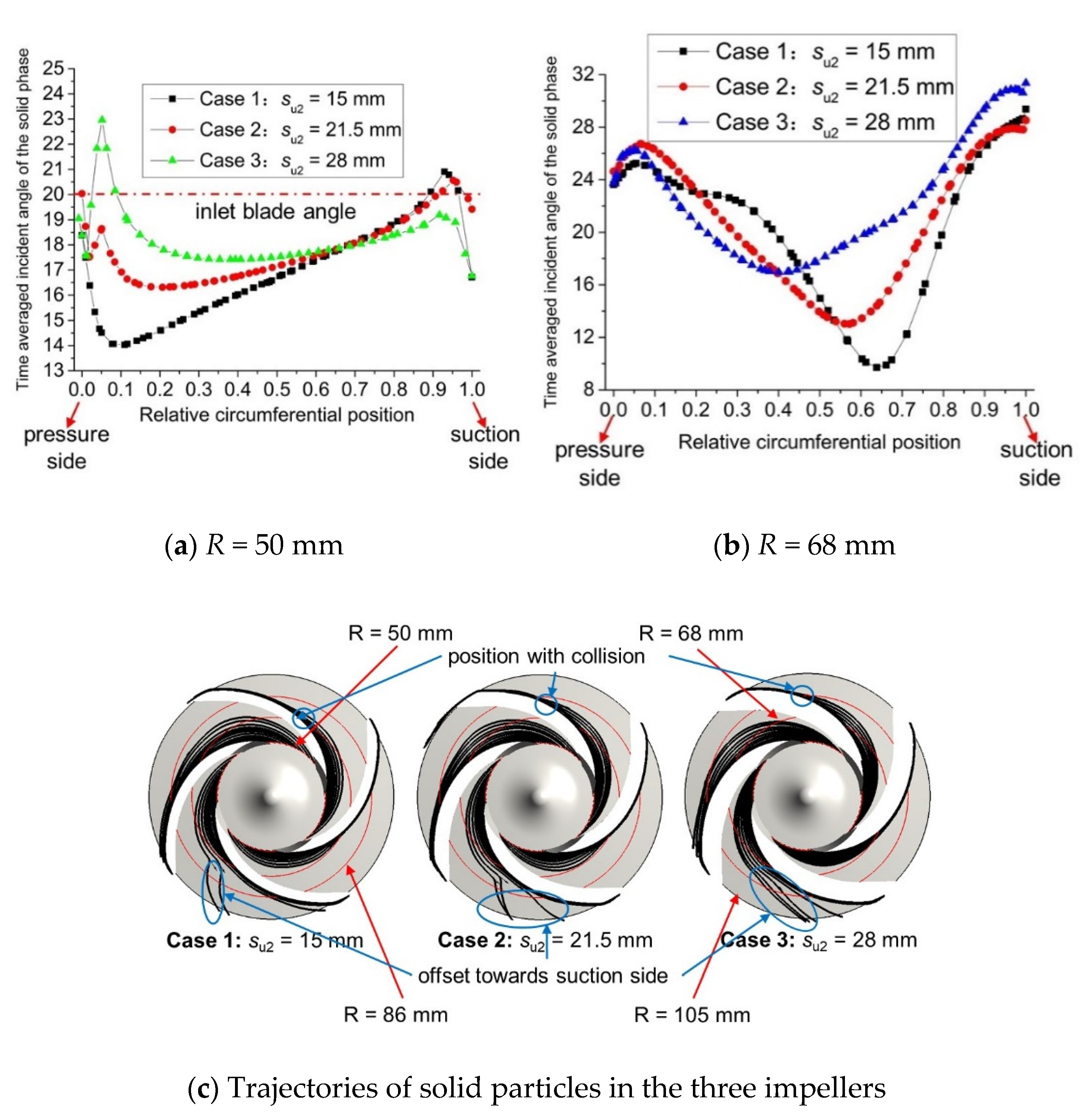
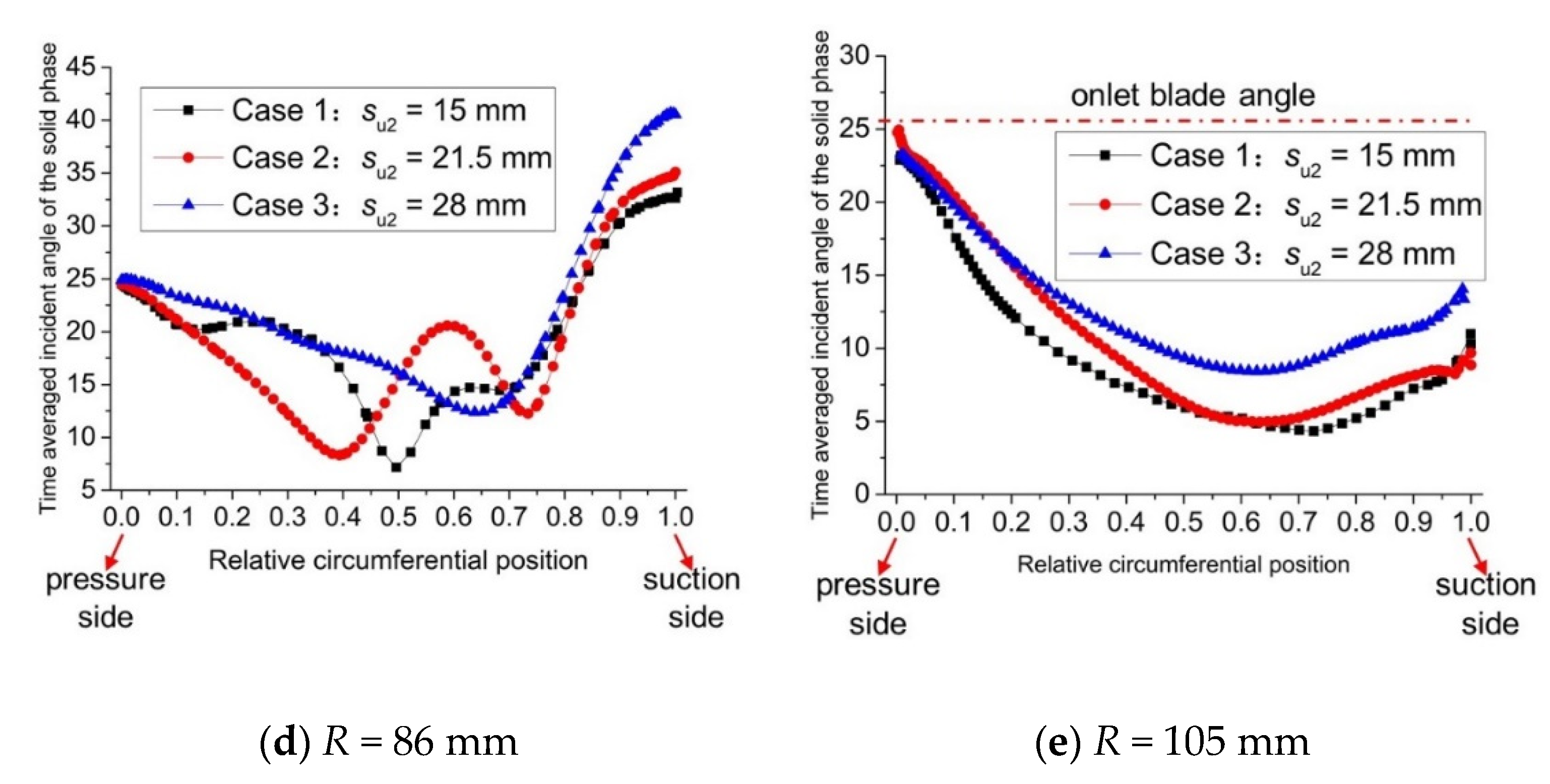
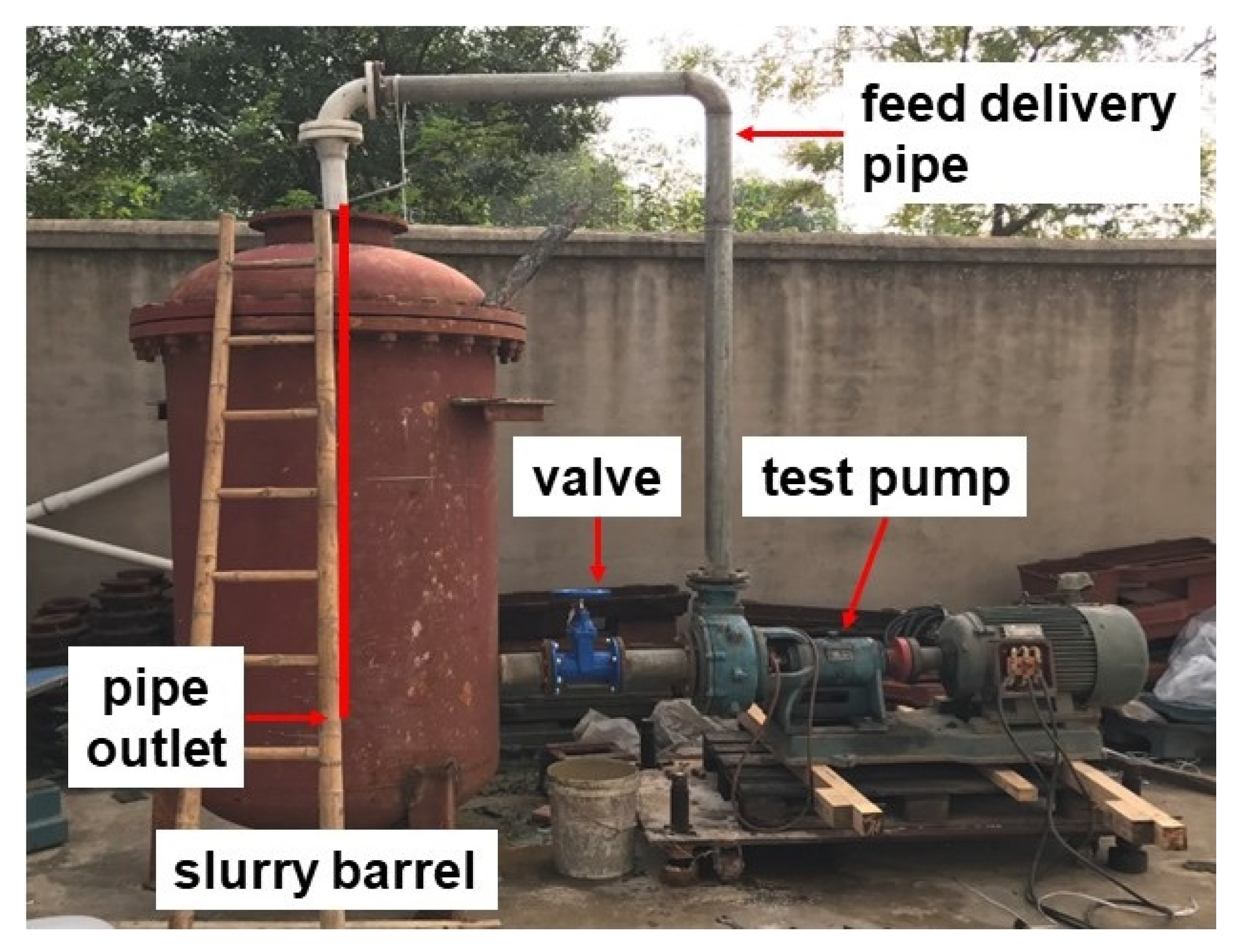
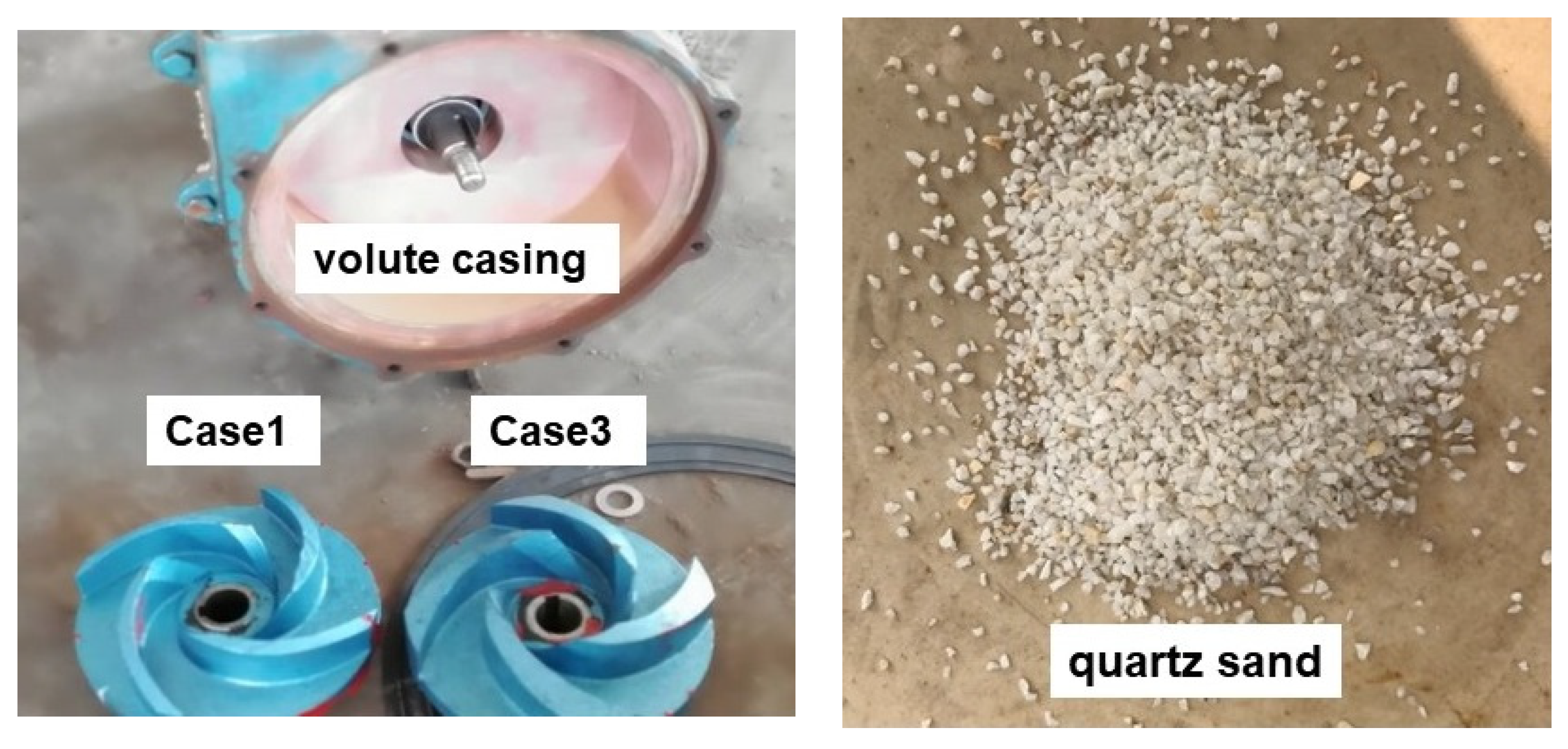
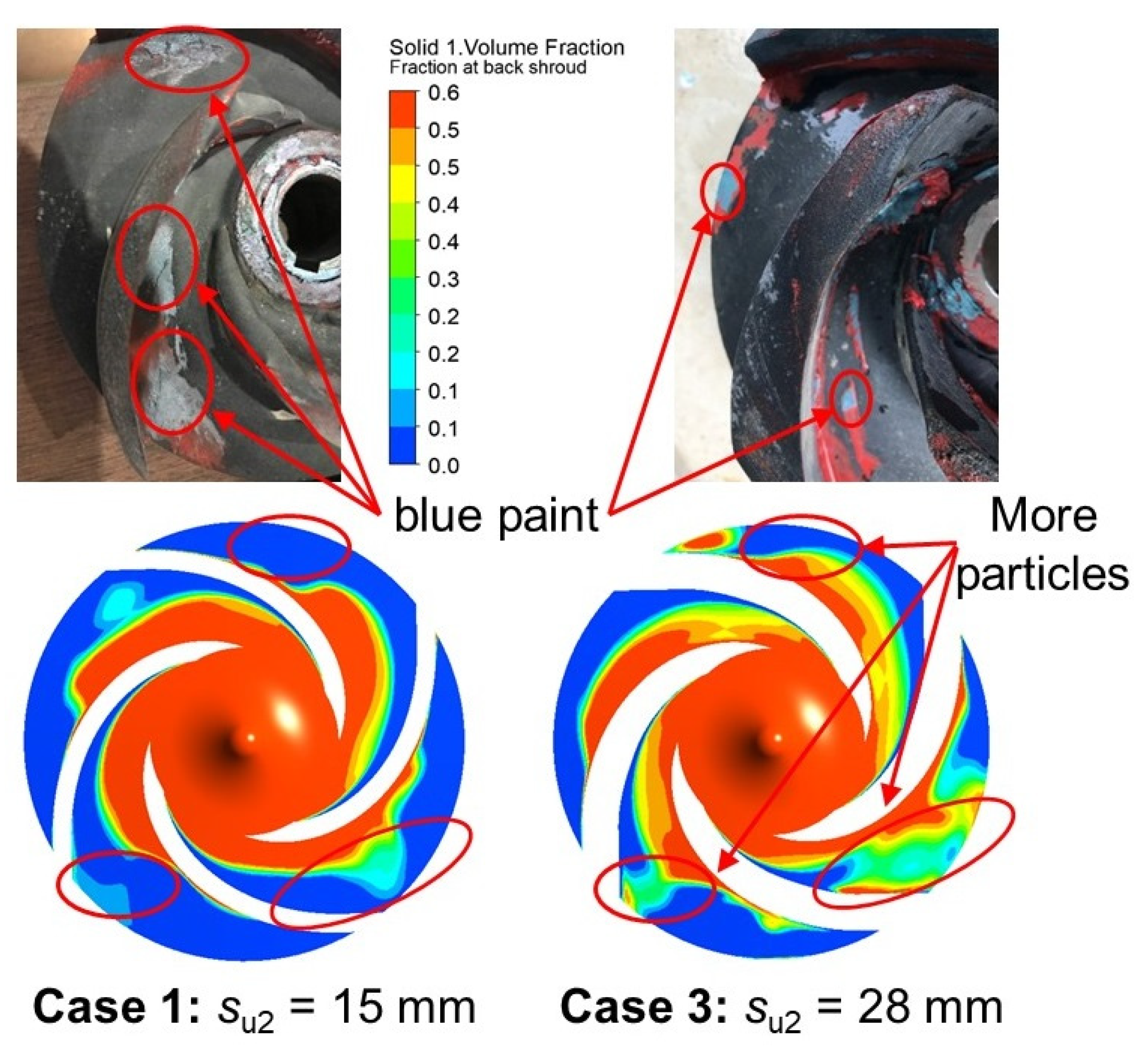


| Description | Parameter | Value |
|---|---|---|
| Suction branch diameter | Ds | 100 mm |
| Discharge branch diameter | Dd | 80 mm |
| Impeller eye diameter | D1 | 90 mm |
| Impeller exit diameter | D2 | 210 mm |
| Leading edge width | b1 | 41 mm |
| Trailing edge width | b2 | 28 mm |
| Inlet blade angle | β1 | 20° |
| Outlet blade angle | β2 | 26° |
| Blade wrap angle | φ | 120° |
| Back blade width | bb | 5 mm |
| Volute chamber width | b3 | 63 mm |
| Diameter to volute tongue | D3 | 287 mm |
| Grid Number | 2,071,856 | 3,115,696 | 4,021,768 | 5,013,874 |
| Head H/m | 47.38 | 48.02 | 48.43 | 48.61 |
| GCI/% | 6.26 | 4.71 | 2.47 | 2.03 |
Publisher’s Note: MDPI stays neutral with regard to jurisdictional claims in published maps and institutional affiliations. |
© 2021 by the authors. Licensee MDPI, Basel, Switzerland. This article is an open access article distributed under the terms and conditions of the Creative Commons Attribution (CC BY) license (https://creativecommons.org/licenses/by/4.0/).
Share and Cite
Tao, Y.; Bai, Y.; Wu, Y. Influence of Blade Thickness on Solid–Liquid Two-Phase Flow and Impeller Wear in a Ceramic Centrifugal Slurry Pump. Processes 2021, 9, 1259. https://doi.org/10.3390/pr9081259
Tao Y, Bai Y, Wu Y. Influence of Blade Thickness on Solid–Liquid Two-Phase Flow and Impeller Wear in a Ceramic Centrifugal Slurry Pump. Processes. 2021; 9(8):1259. https://doi.org/10.3390/pr9081259
Chicago/Turabian StyleTao, Yi, Yongming Bai, and Yingchun Wu. 2021. "Influence of Blade Thickness on Solid–Liquid Two-Phase Flow and Impeller Wear in a Ceramic Centrifugal Slurry Pump" Processes 9, no. 8: 1259. https://doi.org/10.3390/pr9081259
APA StyleTao, Y., Bai, Y., & Wu, Y. (2021). Influence of Blade Thickness on Solid–Liquid Two-Phase Flow and Impeller Wear in a Ceramic Centrifugal Slurry Pump. Processes, 9(8), 1259. https://doi.org/10.3390/pr9081259






